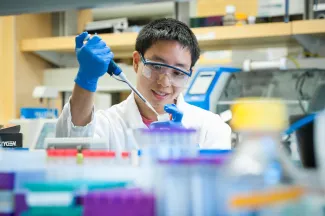
Catherine Brochard-Lalande, Engin Deniz, Julie Jung, Finn Lawlor, Aidan Mitha, Keagan Read and Lily Scholtens
- Community Partner: Hatch Ltd.
- Degree:
- Bachelor of Applied Science
- Program:
- Campus: Vancouver
Our design process and challenges
"We wanted our process to be as energy-efficient and low impact as possible."
One of our biggest design challenges was figuring out how to remove impurities from the black mass feedstock. We needed to remove various metals – including copper, graphite, magnesium, iron and cesium – to isolate our product and purify it to the specifications. This involved a lot of research on solvent extraction and ion exchange. Another challenge was scaling up processes to be viable at the large scale of our plant.
Many benchtop experiments achieved what we were aiming for, but finding the right equations to make this work at a facility with 30,000 metric tonnes of annual capacity required significant research and reaching out to our mentors at both UBC and Hatch We also opted for using a hydrometallurgical process over the more energy-intensive and market-dominant pyrometallurgical process.
The advantage of hydrometallurgy is that it can offer higher efficiency of metals recovery, is less energy intensive and produces fewer pollutants. In fact, the only air emissions released from our process is oxygen. In our proposed process, the black mass is leached with H2SO4 and H2O2 in three continuous stirred tank reactors and then combined with make-up alloy streams. Impurities are removed in three steps using solvent extraction. Nickel, manganese and cobalt are then co-precipitated to metal hydroxides and the end product is washed and dried to meet specifications for use in a new battery.
Our project’s future
The project report we submitted to our client has about 30% of the design detail you’d need to build a feasible plant. We’ll see what Hatch decides to do with it! We are very proud of the work we’ve done and it’s exciting to know that there is a real need out there for projects with this kind of impact.





